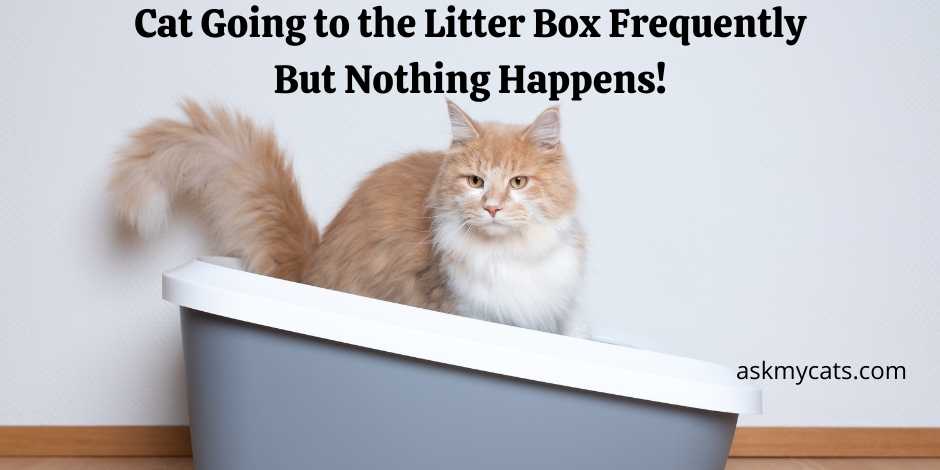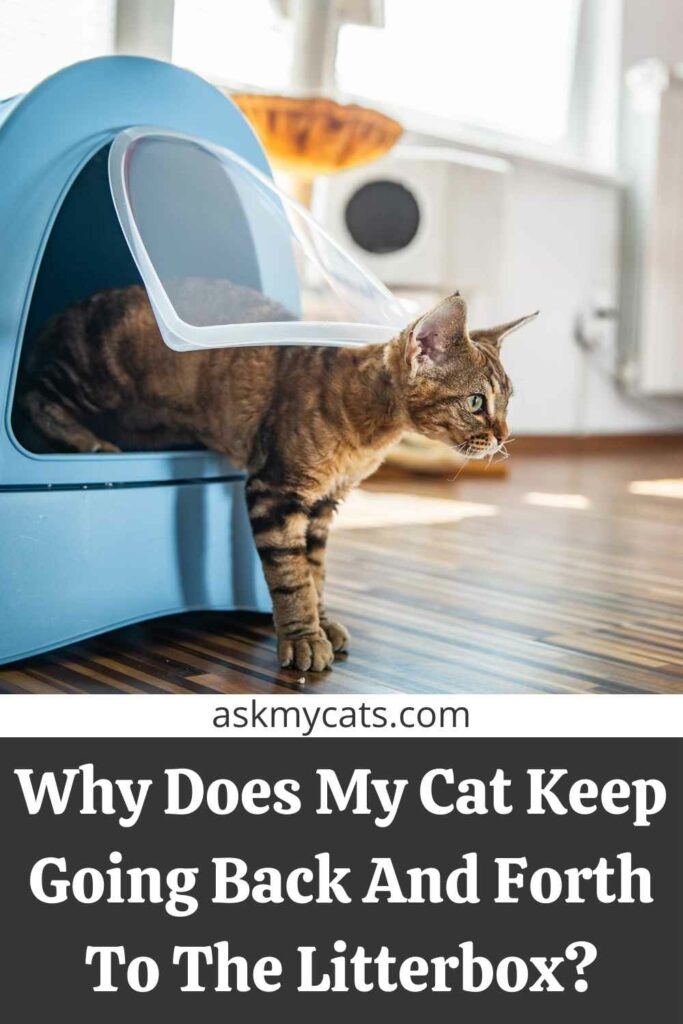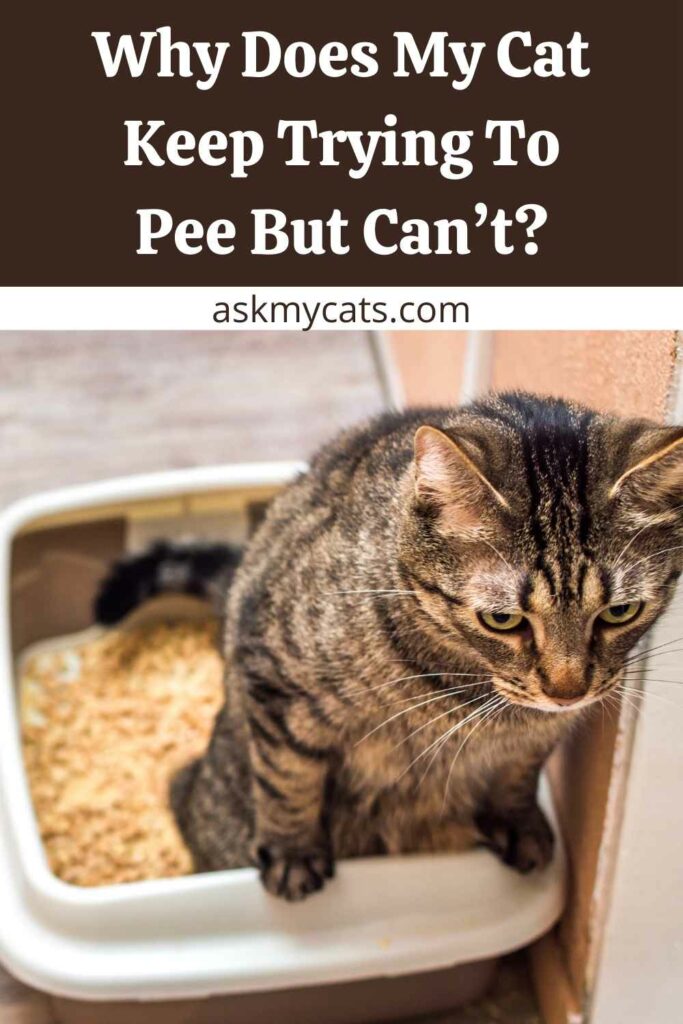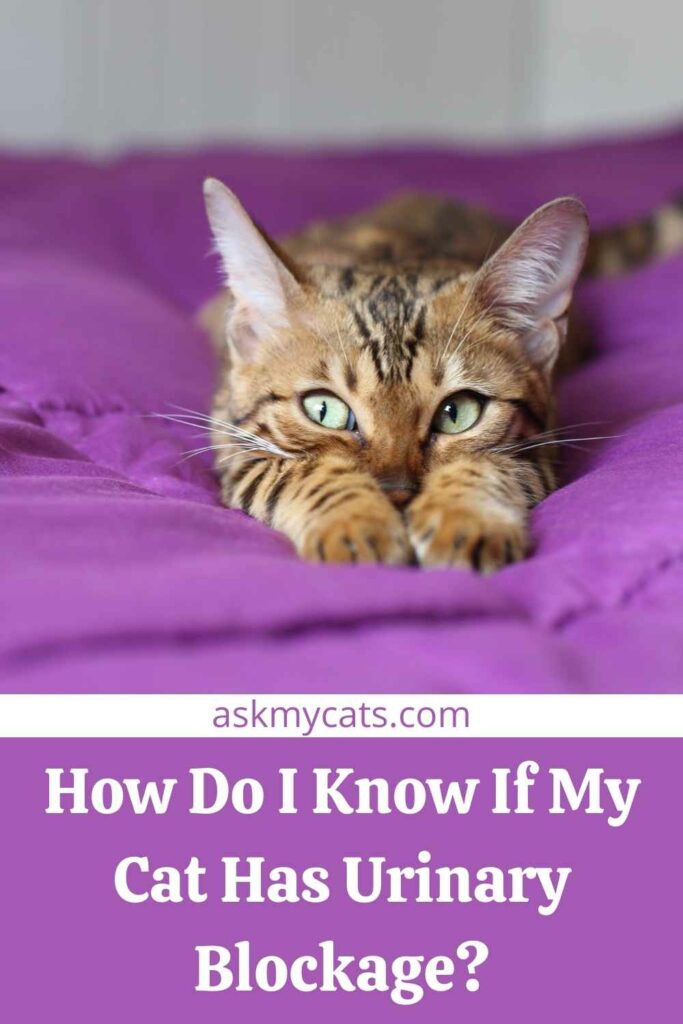Litter box issues affect the majority of cat owners at some time in their life. Cats will sometimes quit using their litter box, while others will continue to use it. Another, less typical issue is when your cat continues to use the litter box but nothing happens.
If your cat continues going inside the litter box but there’s no sign of poop or pee, he’s probably constipated or having urinary blockage and having trouble going to the bathroom. It’s also possible that your cat feels comfortable in their litter box and uses it to hide.
Alternatively, they might be resolving a litter box problem with other cats in your home, or they could just be figuring it out!


Give Your Cat the Perfect Day
Get the Free Ebook!
Why Does My Cat Keep Going Back And Forth To The Litterbox?
If a cat keeps going back and forth to the litterbox, it means though he wants to pee or poop, they are unable to do so due to some medical issues.

A cat will pee two to three times each day on average and poop at least once. The number of times your pet needs to go to the bathroom will vary, but it will be close to these averages. It’s alarming enough to notice your cat using the litter box more frequently than normal.
If he isn’t urinating or pooping, it’s even worse.
Check his stomach first. You will observe that constipated cats’ tummies are strained. You’ll notice that your cat’s feces are firm and dry if he effectively clears his intestines.
Do you hear a strained sound from your cat as he enters the litter box? What about his stance? Have you seen any changes, such as hunching? Is he up to date on his meals? These are some of the tell-tale indicators that your cat is suffering from constipation.
Constipation is a frequent problem in cats. Some of the reasons for these problems are simple to fix, while others need the assistance of a veterinarian.
One of the most common reasons for constipation in cats is dehydration. This should come as no surprise, especially as many cats dislike drinking water.
Constipation can also be caused by a lack of fiber in the diet. Cats, like people, have trouble emptying their intestines if their diet is deficient in fiber.
Constipation can also be linked to a sedentary way of living. If your cat spends most of his days napping and laying around your house, his intestines will not be able to move as freely as they should, resulting in constipation.
Intestinal obstructions can be caused by eating foreign things such as hair. However, before your cat develops constipation, he will exhibit other signs such as a lack of appetite and stomach pain.
Constipation can be an indication of a greater medical problem, such as hernias, tumors, or nerve diseases. It’s likely that your cat gets constipated as a result of his medicine.
Since they don’t use their litter boxes, some cats develop constipation. Cats are picky creatures that will avoid using the litter box if they believe it stinks or is too filthy.
You might also like to read reasons for cat will pee but not poop in litter box
Why Does My Cat Keep Trying To Pee But Can’t?
Your cat is suffering from a urinary tract infection that affects the bladder or kidneys if they keep trying to pee but can’t.

They might possibly have a renal calculus (kidney stone) or infection-related enlargement of the urethra. Some cats are prone to urinary problems and will have problems on occasion.
Your cat could be having trouble peeing and will have to strain to get it out. It’s another story when they can’t pee at all. If your cat is unable to urinate at all, you must take them to an emergency veterinarian. Urinary incontinence can be lethal.
A urinary tract infection, bladder stones, or blood clots are all signs of blood in the urine. These issues can cause irritation, and infection can lead to urethral blockage.
Your cat is unable to urinate in the litterbox because when cats have a UTI, they frequently pee outside of their litterbox. When a cat is in discomfort when urinating, they identify the box with the pain, thus they urinate outside of it.
Cystitis is a bladder infection caused by a bacterial infection, mineral imbalance, and pH values that are abnormal. The formation of small mineral crystals in the cat’s urine is known as cystitis. These crystals can produce unsettling stones that can be very debilitating.
It can produce a serious blockage in the urethra, making it difficult or impossible for your cat to urinate.
When a cat has urination issues or is unable to urinate at all, it’s critical to figure out what’s causing the problem so you and your veterinarian can come up with a treatment plan that works for both of you.
Check out the reasons for cat sitting in litter box doing nothing
Why Is My Cat Squatting But Not Peeing?
Your cat is squatting but not peeing because he is suffering from urinary obstruction.
Feline Lower Urinary Tract Disease in Cats (FLUTD) When you find your cat unable to pee or struggling to urinate, you know he or she is in pain.
Cystitis, often known as bladder inflammation, is the most common cause of straining. If you’ve ever had cystitis, you’ll understand what your cat is going through.
The cat will try to urinate often but will produce little or no pee, which is generally blood-tinged. In the obstructed cat, more severe symptoms may appear.
A blocked cat is virtually invariably male due to anatomical abnormalities. The cat will frequently scream out in pain and become increasingly sedentary.
This is because the urine cannot be evacuated from the bladder, causing the cat to become very unwell and potentially lethal.
How Do I Know If My Cat Has Urinary Blockage?
Your cat will have a urinary blockage if they are unable to pass any urine at all.

Urinary obstructions can happen in female cats, although they are relatively uncommon. Males are more prone than females to have a blockage because their urethra is thinner and longer, making it simpler to obstruct.
So, if your male cat continues going to the litter box but nothing happens, this is a lot more likely cause.
This is frequently caused by crystals forming and accumulating in the urethra, bladder, or elsewhere in the urinary tract. They can obstruct the passage of urine if enough form forms, making it exceedingly difficult for your cat to urinate.
A bladder infection is another possibility. The bladder lining might become irritated and expand, preventing urine from passing through. Your cat might also be suffering from bladder stones, which are mineral deposits that accumulate inside the bladder.
These come in a variety of sizes, but big ones can prevent urine from passing through the tract. If your cat is unable to discharge pee, it is a medical problem that has to be addressed immediately.
It can lead to renal failure and cardiac problems if left unchecked. In the worst-case scenario, the bladder might explode, resulting in death.
Your cat’s bladder will need to be cleared to resolve the problem. Vets will sometimes achieve this by placing a tube up the urethra, while other times the obstruction will need to be surgically removed.
The best ways to avoid cystitis are to feed your cat high-quality food, drink lots of fresh water, and keep your litter box clean.
If your cat has had stones, has been “blocked,” or has had several bouts of cystitis, she will be put on a prescription diet that will change the substance of her urine and reduce the chance of recurrence.
There are various brands of this sort of food available, but if your cat refuses to eat any of them, there is a medicine available that can alter the pH of the urine, perhaps preventing recurrence. Both approaches, however, usually need lifelong care.
How Can I Unblock My Cat’s UTI At Home?
You can give cranberries to your cat to unblock your cat’s UTI simply at home.
Cranberries are commonly used to treat UTIs in people, but they can also be used to cure UTIs in cats. Cranberries’ acidity can help cure a UTI and prevent it from recurring by lowering the pH of your cat’s urine.
The sugar content of many cranberry drinks is significant. To boost your cat’s food, look for cranberry capsules (pills), supplements, or powder.
You should examine the pH levels in your cat’s urine before giving him cranberries. While the acidity of cranberries may assist with certain UTIs, it may aggravate the problem in others. If your cat’s urine is overly alkaline, just give him cranberry supplements.
Urinary tract infections are prevalent in cats and can cause a lot of pain and suffering. A UTI can cause partial or full urethral obstruction if left untreated. This can result in renal failure or bladder rupture, both of which can be fatal.
A cat UTI can be treated using at-home cures and medications, depending on the severity of the illness.
Also, check out Why Is My Nursing Cat Not Peeing Or Pooping After Birth?
Frequently Asked Questions
What do I do if my cat keeps going in the litterbox?
Your cat may have a urinary tract infection if she accesses her litter box regularly but only produces little volumes of pee. Consult a veterinarian to rule out any medical issues. Feline interstitial cystitis is a neurological condition that affects a cat’s bladder (the term “cystitis” refers to an inflamed bladder).
Why is my cat squatting but not pooping?
Cats with arthritis may have problems crouching or crawling up and down stairs to access the litter box. Diets poor in fiber, trauma (such as a shattered pelvis), certain medicines, gastrointestinal blockages, and even a lack of exercise are all possible causes.
Is my cat struggling to pee or poop?
If your cat isn’t pooping on a daily basis or is straining to do so in the litter box, it might be an indication of constipation that needs medical treatment. Just be sure you don’t mix up straining to defecate (which is unpleasant but not necessarily a medical issue) with straining to pee (a very serious medical emergency).
Final Words
The first step is to take your cat to the veterinarian to ensure that he or she does not have constipation or urinary obstruction.
If you’ve been given the all-clear on these medical conditions, there’s nothing to be concerned about, and there are lots of things you can do at home to help your cat.
Leave your questions in the comments section below.
